Shopping Cart
- Remove All
 Your shopping cart is currently empty
Your shopping cart is currently empty

Ruthenium Red (Ammoniated ruthenium oxychloride) is a polycationic dye widely used for electron microscopy (EM) of cells, tissues and vegetative bacteria. Ruthenium red strongly reacts with phospholipids and fatty acids and binds to acidic mucopolysaccharides. Ruthenium red is a L-type calcium current (ICa) blocker, blocks Ca2+ uptake and release, and voltage-sensitive Ca2+ channels

| Pack Size | Price | Availability | Quantity |
|---|---|---|---|
| 100 mg | $45 | In Stock | |
| 500 mg | $101 | In Stock |
| Description | Ruthenium Red (Ammoniated ruthenium oxychloride) is a polycationic dye widely used for electron microscopy (EM) of cells, tissues and vegetative bacteria. Ruthenium red strongly reacts with phospholipids and fatty acids and binds to acidic mucopolysaccharides. Ruthenium red is a L-type calcium current (ICa) blocker, blocks Ca2+ uptake and release, and voltage-sensitive Ca2+ channels |
| Alias | Ammoniated ruthenium oxychloride |
| Molecular Weight | 786.34 |
| Formula | Cl6H42N14O2Ru3 |
| Cas No. | 11103-72-3 |
| Smiles | N.N.N.N.N.N.N.N.N.N.N.N.N.N.[Ru][Ru](=O)[Ru]=O.Cl[Cl](Cl)[Cl](Cl)Cl |
| Relative Density. | 3.11 |
| Storage | keep away from direct sunlight,store under nitrogen | Powder: -20°C for 3 years | In solvent: -80°C for 1 year | Shipping with blue ice. | |||||||||||||||||||||||||
| Solubility Information | H2O: 20 mg/mL (25.43 mM), Sonication is recommended. DMSO: 20 mg/mL (25.43 mM), Sonication is recommended. | |||||||||||||||||||||||||
Solution Preparation Table | ||||||||||||||||||||||||||
H2O/DMSO
| ||||||||||||||||||||||||||

Copyright © 2015-2025 TargetMol Chemicals Inc. All Rights Reserved.